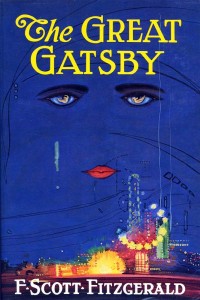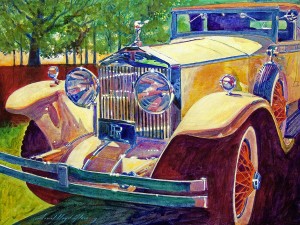I recently read The Great Gatsby in my English 368 class with Professor Conner. I remember reading this “Great American Novel” during my sophomore year of high school. My reading of the book then was definitely a little “sophomoric.” It is amazing to me how much more I understand and am able to glean from the novel at the college level. Professor Conner, who has read it upwards of fifty times, discussed how different we look at books each time we read them. As we grow older, we reread literature with new eyes. In high school, I did understand some of the symbolism and use of colors throughout the novel. Daisy is characterized as pure white, an innocent flower in Gatsby’s eyes. Myrtle, Tom Buchanan’s mistress, wears a cream colored dress, which Nick describes as a “costume.” In the presence of millionaires and away from the Valley of Ashes, her vitality quickly transforms into “impressive hauteur.” Fitzgerald uses critical language, describing her as “more violently affected moment by moment.” While Daisy was born into the world of old world wealth, Myrtle is the wife of George Wilson, the owner of an auto shop. Nick, caught between these two worlds, observes these contrasting female characters throughout the book. They can be considered as women emblematic of innocence and experience, the polar ideals that Fitzgerald also applies to his commentary of the American nation.
Professor Conner, who has read it upwards of fifty times, discussed how different we look at books each time we read them. As we grow older, we reread literature with new eyes. In high school, I did understand some of the symbolism and use of colors throughout the novel. Daisy is characterized as pure white, an innocent flower in Gatsby’s eyes. Myrtle, Tom Buchanan’s mistress, wears a cream colored dress, which Nick describes as a “costume.” In the presence of millionaires and away from the Valley of Ashes, her vitality quickly transforms into “impressive hauteur.” Fitzgerald uses critical language, describing her as “more violently affected moment by moment.” While Daisy was born into the world of old world wealth, Myrtle is the wife of George Wilson, the owner of an auto shop. Nick, caught between these two worlds, observes these contrasting female characters throughout the book. They can be considered as women emblematic of innocence and experience, the polar ideals that Fitzgerald also applies to his commentary of the American nation.
The image of a young Daisy is preserved in Gatsby’s mind; she is the idealized object of his hopeless love. During their climactic confrontation in a New York hotel room, Gatsby begs Daisy to tell Tom that she never loved him and has only loved Gatsby all of these years. Gatsby desperately wants Daisy to wipe away her marriage to Tom, erasing that time in her life. Attempting to return her to the idealization he clings to in his mind, he longs for the pure, innocent female archetype. Daisy, however, admits she has loved both men, crying that Gatsby “[wants] too much.” Unable to handle this heated confrontation, Daisy speeds off in Gatsby’s car and accidentally kills Myrtle Wilson. Daisy is truly not the innocent flower that Gatsby envisions.  Myrtle is portrayed very differently throughout the novel. Myrtle, who has an affair with Daisy’s husband, is described as possessing a sensual vitality. She is the symbol of experience, using her sexuality to advance her social status and to live a life away from the depressed valley of ashes. The roles of innocence and experience are shifted after Myrtle’s death: Myrtle is the victim, the woman who faces the violence and corruption of this elite world. Daisy’s image is tarnished; she is no longer the fairy tale that Gatsby has clung to for so many years.
Myrtle is portrayed very differently throughout the novel. Myrtle, who has an affair with Daisy’s husband, is described as possessing a sensual vitality. She is the symbol of experience, using her sexuality to advance her social status and to live a life away from the depressed valley of ashes. The roles of innocence and experience are shifted after Myrtle’s death: Myrtle is the victim, the woman who faces the violence and corruption of this elite world. Daisy’s image is tarnished; she is no longer the fairy tale that Gatsby has clung to for so many years.
An adaptation of The Great Gatsby, a film by Baz Luhrmann, will be released this May. Washington and Lee has also embraced this cornerstone of American literature. The Fancy Dress 2013 theme, “A Night at Gatsby’s,” was recently announced.

